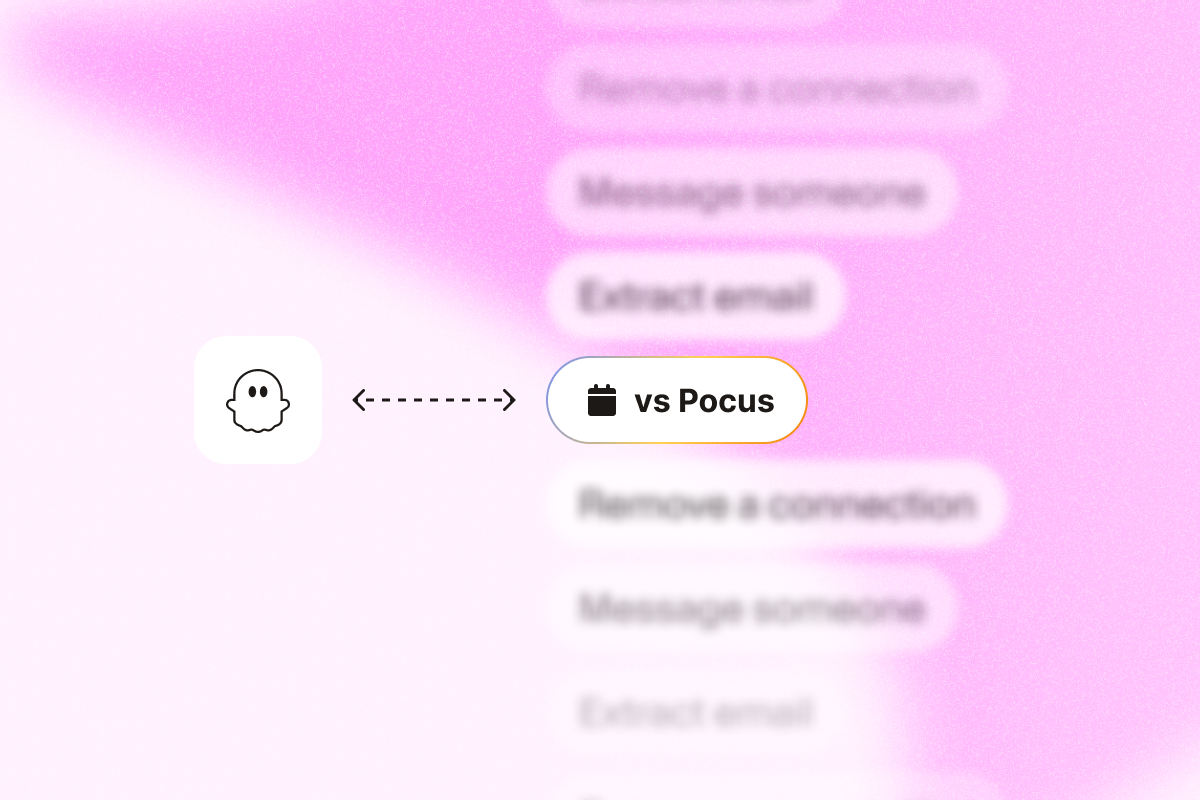PhantomBuster and Pocus are two sales automation platforms that solve different parts of the prospecting and prioritization workflow.
PhantomBuster puts control in the hands of outbound teams, offering pre-built automations that you can chain into complete outbound workflows to extract, enrich, and engage leads from public sources.
Pocus leans into AI and product-led sales, helping go-to-market teams prioritize accounts based on behavior and intent.
Below, you’ll see how PhantomBuster (outbound automation) compares to Pocus (product-led prioritization) so you can pick the right fit for your motion and budget in 2025.
PhantomBuster and Pocus at a glance
PhantomBuster is best for LinkedIn outbound automation and data extraction. It’s ideal for teams that need hands-on control of lead extraction, enrichment, and outreach across LinkedIn and other public platforms to enhance lead generation.
Pocus is best for product-led sales prioritization. It shines when you have rich product usage data and want AI to surface high-intent leads and provide actionable insights.
| Feature | PhantomBuster | Pocus |
| Primary function | LinkedIn prospecting automation and outreach | Product-led sales insights and lead prioritization |
| Target users | Sales reps, BDRs | Product-led sales teams, revenue operations |
| Core technology | Pre-built automations | Predictive analytics and lead scoring |
| Data approach | Real time data extraction and enrichment | Analysis of internal product usage data |
How these tools work: copilot vs. autopilot approaches
PhantomBuster overview: Copilot approach
PhantomBuster is a sales prospecting automation platform that gives reps hands-on control over how and when outreach happens. Think of it as a copilot: you set the target accounts, and it handles the busywork so you can build pipeline.
PhantomBuster gives reps full visibility and control over every part of their outreach process while eliminating repetitive tasks.
How PhantomBuster works
It transforms manual prospecting activities, such as searching LinkedIn, collecting contact details, sending connection requests, and exporting leads to CRMs, into fully automated workflows using configurable building blocks (automations).
This removes manual steps like copy-pasting leads into your CRM, freeing hours per week for live conversations.
Each workflow is a pre-built automation that completes a specific step. Users can set parameters, choose data sources, and schedule when automations run.
Everything runs through PhantomBuster’s visual dashboard, where users can stack automations together into multi-step workflows, monitor execution in real time, and adjust campaign logic as needed to maximize sales efficiency.
Chain PhantomBuster automations to search LinkedIn, extract public profile details, enrich contacts, sync to HubSpot, then trigger outreach, within platform guidelines.
Within PhantomBuster, combine these built-in capabilities in one workflow:
- PhantomBuster’s LinkedIn Search Export automation: Extract public profile fields (e.g., name, title, company). For business emails, add email discovery and verification in the same workflow.
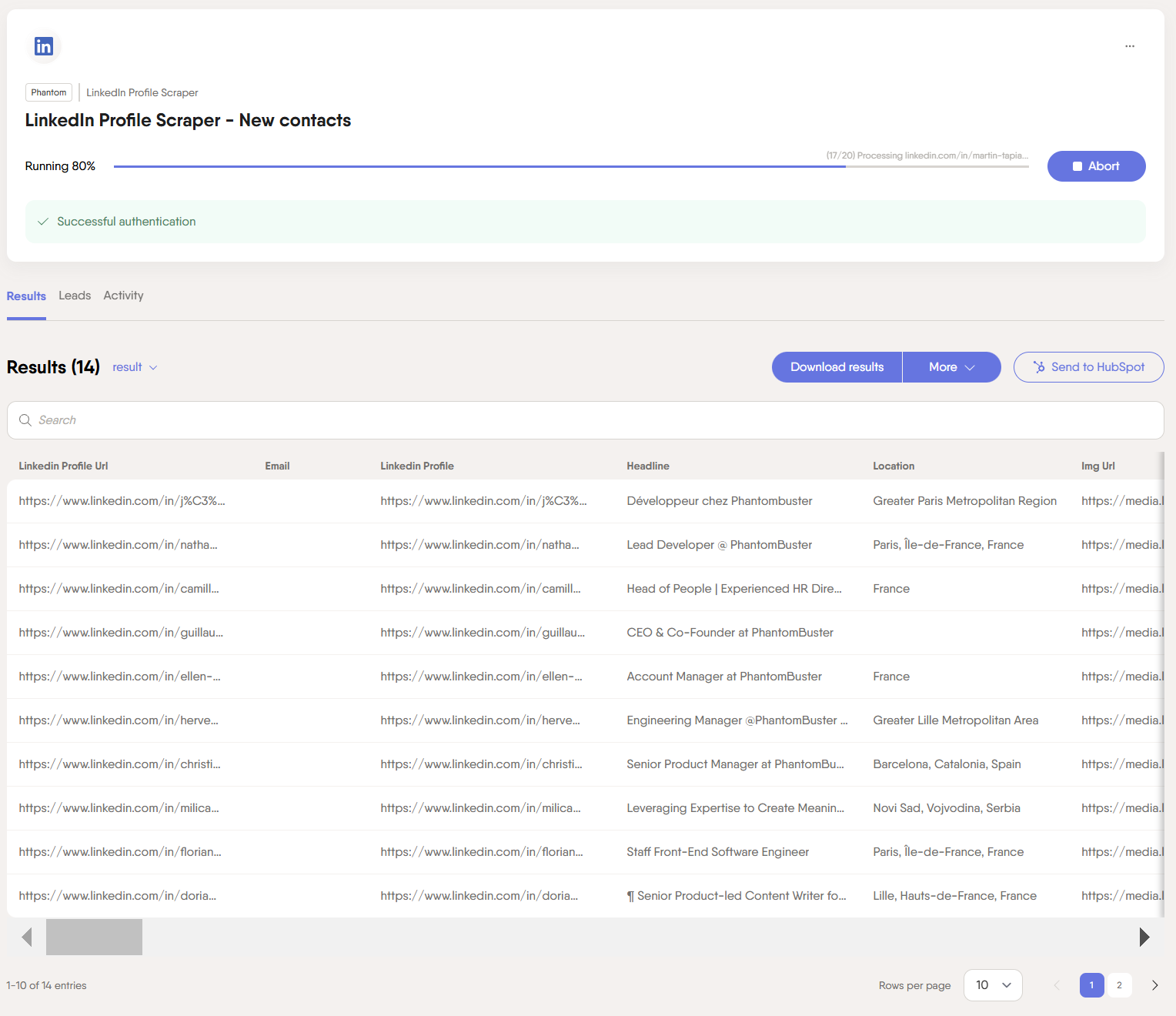
- PhantomBuster’s AI LinkedIn Profile Enricher: Uses AI to qualify leads based on role, seniority, and ICP match, helping teams filter high-potential leads faster by analyzing data points.
- PhantomBuster’s AI LinkedIn Message Writer. Draft personalized LinkedIn messages based on the contact’s profile. Reps can edit and approve each message before sending.
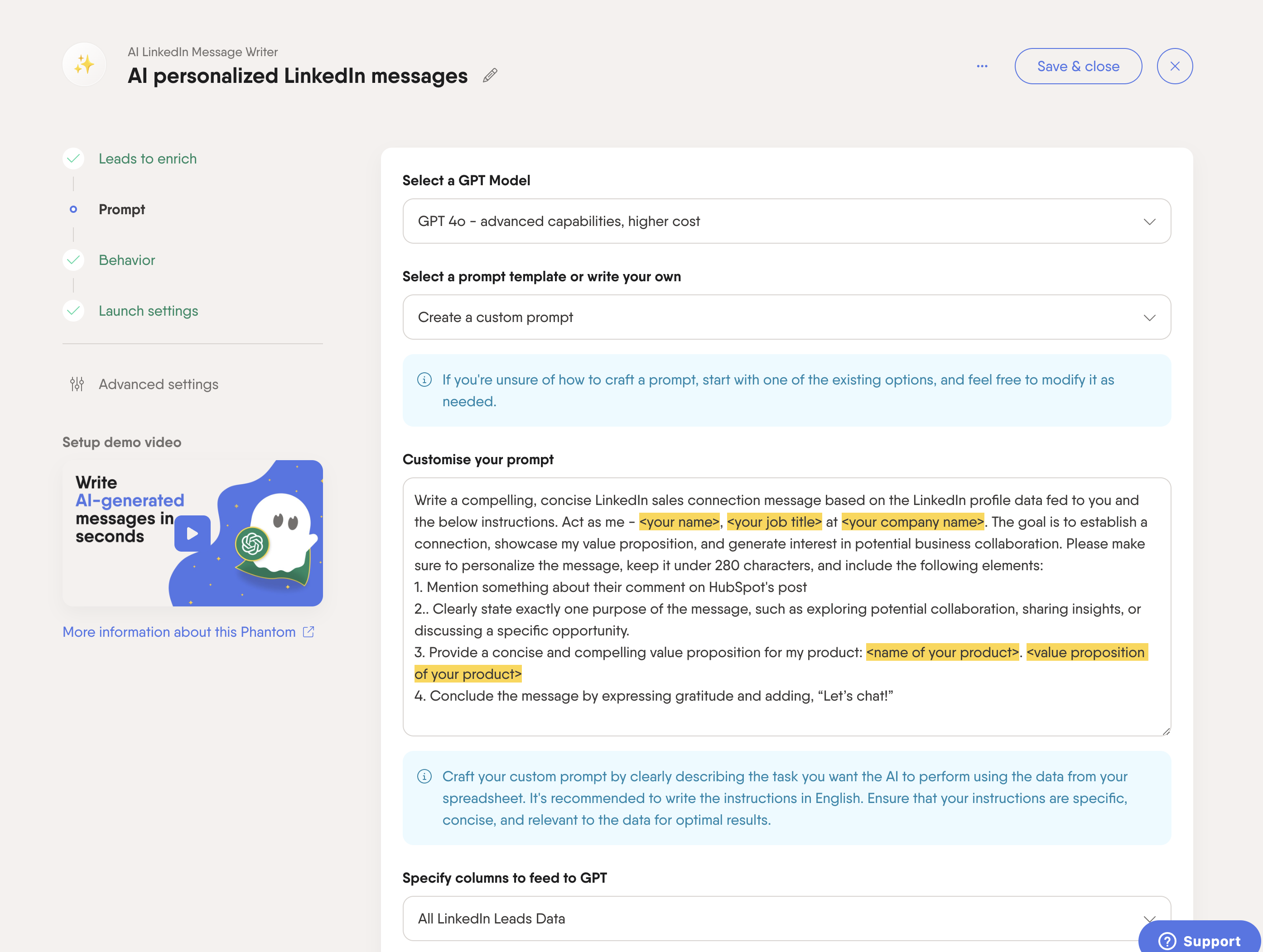
- PhantomBuster Chrome extension. Discover verified business emails and phone numbers from connected providers, displayed alongside the profile, so you don’t switch tabs. Company insights help you qualify leads instantly.
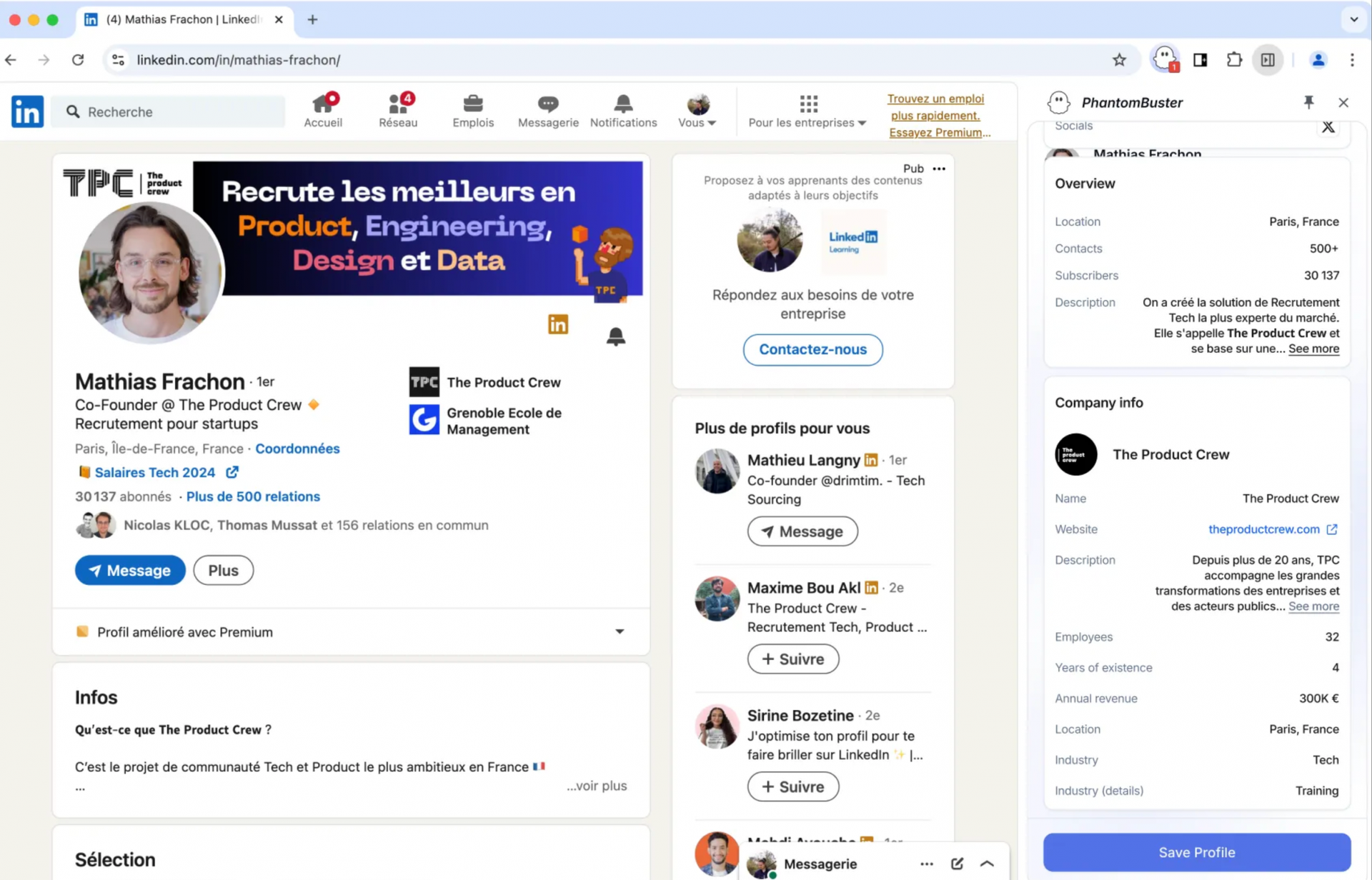
Users can create and manage hundreds of automations from a single dashboard, track usage limits, and manage workspaces for different brands or clients, and operate within each platform’s usage policies, all within one workspace.
💡PhantomBuster is best suited for small to mid-sized sales teams that want full control over their outbound prospecting process, especially those focused on LinkedIn outreach, data enrichment, and scalable list building.
Pocus overview: The autopilot approach
Pocus prioritizes accounts for PLG companies by analyzing product usage and CRM data.
Instead of requiring manual setup or workflow orchestration, Pocus continuously scores accounts and alerts reps when buying signals spike, surfacing high-quality leads based on real-time user behavior.
How Pocus works
Pocus connects to your product analytics, CRM, and data warehouse to track in-app behaviors, including feature adoption, login frequency, team expansion, and trial milestones.
It then enriches that customer data with real-time intent signals (from tools like Clearbit, Bombora, or LinkedIn) to paint a complete picture of each account’s buying readiness.
Reps get a ranked account list with the reason to reach out (e.g., team invite, usage spike, billing page view).
Pocus includes AI-powered capabilities that score and prioritize accounts, alert reps and trigger plays, and sync data across platforms:
- AI opportunity scoring. Pocus agents score and rank accounts based on product usage, ICP fit, and external buying signals, updating continuously as behaviors change to support sales forecasting.
- Live opportunity feed. Instead of static dashboards, reps receive a real-time stream of recommended accounts to engage with, based on usage thresholds or trigger events.
- Custom playbooks. Teams can enhance their sales strategy by creating rules-based workflows that trigger specific actions (e.g., upselling, converting trials, re-engaging) when target behaviors are met.
- Usage-based alerts and triggers. Reps are notified when key accounts expand their teams, reach upgrade milestones, or exhibit signs of churn, enabling them to initiate timely outreach efforts.
Pocus connects to your CRM, product analytics, and warehouse, including Salesforce, HubSpot, Segment, Mixpanel, Looker, and Snowflake.
Admins configure workspaces by team. They can test and deploy models, and align playbooks to buyer journeys in one backend.
💡Pocus is best for enterprise sales and RevOps teams at product-led companies that want AI-powered lead prioritization based on behavior while processing inbound leads efficiently.
Why the distinction matters
| Factor | PhantomBuster (Copilot) | Pocus (Autopilot) |
| Control Level | Complete user control over automations | AI-driven recommendations and alerts |
| Learning Curve | Short setup for core workflows | Requires upfront data work and AI training |
| Daily Workflow | Configure and monitor extractions | Review AI-generated opportunities |
| Data Approach | Extract then analyze | Analyze then recommend |
| Team Structure | Individual reps and small teams | Enterprise sales teams with specialists |
PhantomBuster vs Pocus general overview: Use cases, features, pros and cons
PhantomBuster offers automated sales outreach features for B2B prospecting and LinkedIn lead generation
PhantomBuster is designed for sales professionals who require precise control over their sales game. This makes it ideal for:
- SDRs needing to build high-volume prospect lists from public data sources
- Marketing teams enriching CRM records with verified contact info
- Agencies running multi-client prospecting campaigns across niches
Key outcomes PhantomBuster delivers
- Use AI for lead scoring with PhantomBuster’s LinkedIn Profile Enricher: Know which leads to prioritize by scoring them based on key criteria, which in turn improves your sales and marketing efforts.
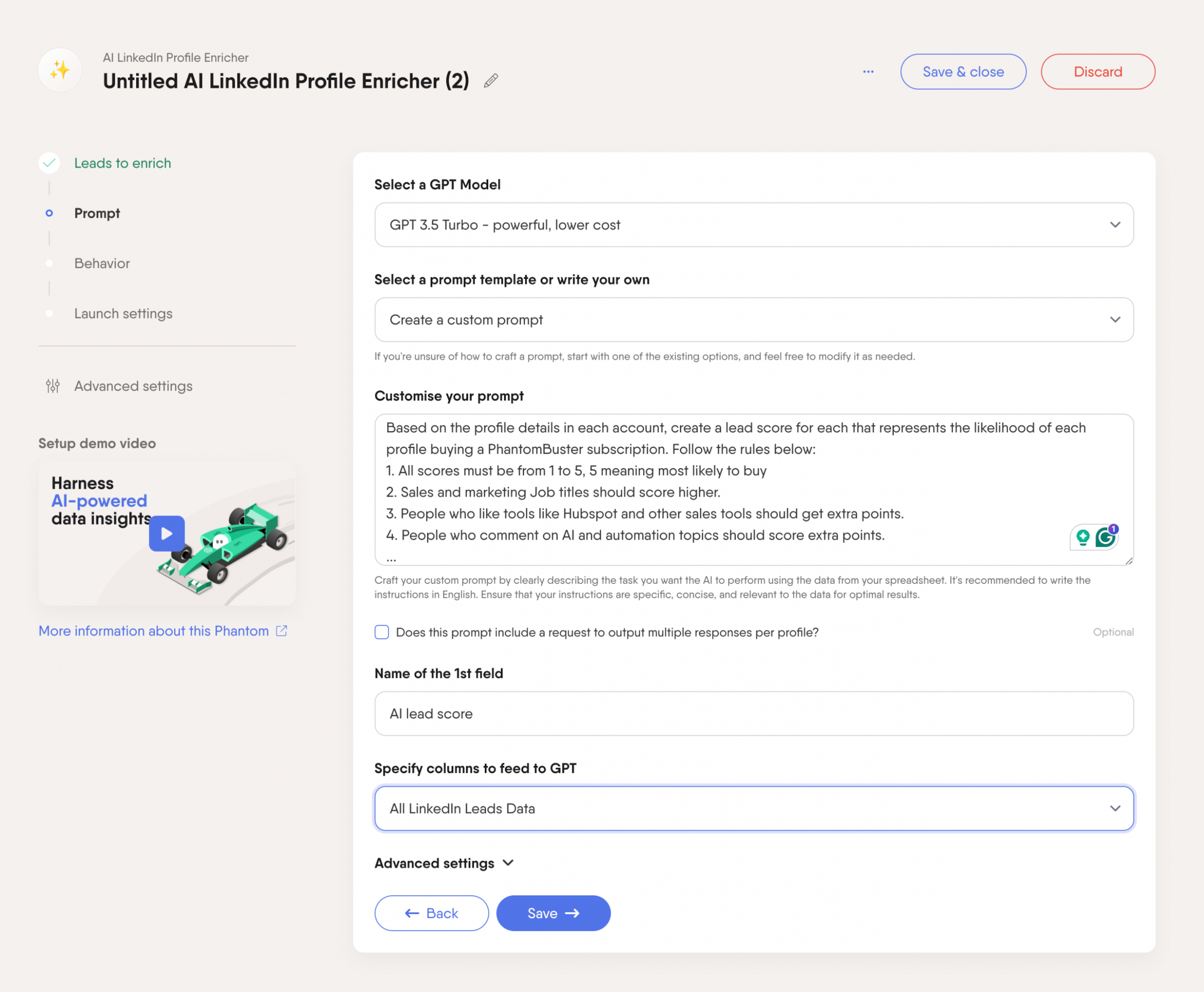
- Sync clean records to HubSpot or Salesforce automatically after verification: With built-in integrations for your CRM, you can keep dirty data out of your contact lists and ensure everything is ready to use without wasting time on manual data entry.

- Use PhantomBuster’s AI LinkedIn Message Writer to draft 1:1 messages from profile context: Edit before sending and avoid mass, unsolicited outreach.
- Build lead lists from engagement signals: Use automations like LinkedIn Post Commenters and Company Page Followers to identify people who engage with specific LinkedIn profiles or companies. This keeps your pipeline filled with freshly sourced warm leads and supports account-based marketing efforts. Use for targeted outreach that respects platform policies.
- Add built-in email discovery and verification to validate addresses before syncing to your CRM.
| Pros | Cons |
| Low-cost plans are ideal for small teams | Requires manual setup and testing |
| Free tier lets you try before buying | Scores leads via profile enrichment; does not provide full account-level scoring like Pocus |
| Respects platform usage guidelines and encourages targeted, personalized outreach over mass messaging | Automation may break with LinkedIn changes |
What users like about PhantomBuster
Users highlight no-code setup, cloud execution, and reliable LinkedIn outreach.
What users dislike about PhantomBuster
There’s a learning curve for advanced workflows, and platform changes may require updates.
Pocus turns product usage data into sales opportunities
Pocus is a sales automation platform purpose-built for sales teams at product-led growth (PLG) companies, serving as both AI-powered sales software and analytics tool. This makes it a perfect fit for:
- Enterprise AEs juggling hundreds of freemium or trial users
- RevOps leaders who need more intelligent sales forecasting
- PLG SaaS companies scaling their sales-assist motions or hybrid GTM strategies
Key outcomes Pocus delivers
- Automatically qualify leads based on product usage: With AI-powered scoring, Pocus identifies which accounts are most likely to convert by analyzing in-product behavior, firmographics, and custom rules, eliminating the need for manual lead qualification.
- Get real-time alerts when accounts show intent: Whether a user invites teammates, hits a usage milestone, or views your pricing page, Pocus sends instant alerts so your team can act while interest is high.
- Keep your data in sync across platforms: Pocus connects natively to tools like Segment, Mixpanel, Salesforce, and HubSpot, ensuring that all lead, usage, and enrichment data are updated in real-time across your entire sales stack.
- Surface the most relevant accounts, daily: Instead of static lists, reps get a prioritized feed of accounts with context on why they’re ready, saving hours of digging and helping teams focus on high-impact outreach.
| Pros | Cons |
|---|---|
| Real-time alerts surface high-intent accounts instantly | Onboarding requires upfront data work |
| No manual scoring, AI qualifies leads based on usage signals | Pricing is custom and not publicly listed |
| Native integrations with tools like Segment and Salesforce | Not ideal for cold outbound or non-product-led teams |
What users like about Pocus
Users praise Pocus for transforming outbound engines, highlighting internal data signals, and saving reps hours with AI-driven sales assistance.
What users dislike about Pocus
Some users find it challenging to set up filters on lists and playbooks to ensure they run as expected based on product signals.
ROI comparison: Cost vs results analysis
PhantomBuster pricing breakdown
| Plan | Price (billed annually) | Execution Hours/Month | Automation Slots | AI Credits | Email Credits/Month |
| Starter | $56/month | 20 hours | 5 | 10,000 | 500 |
| Pro | $128/month | 80 hours | 15 | 30,000 | 2,500 |
| Team | $352/month | 300 hours | 50 | 90,000 | 10,000 |
Return on investment (ROI):
- Customers report saving hours per week by automating list building and CRM sync.
- Most teams get core automations live in days, then expand workflows over the first few weeks.
- Adding enrichment and CRM sync to outreach reduces manual work across list building, qualification, and follow-ups.
Pocus investment considerations
Now, here’s where pricing gets tricky.
Pocus uses custom enterprise pricing. Contact sales for a quote. Many PLG teams budget in the five-figure range annually. This model applies to:
- Team size
- Volume of product and CRM data
- Levels of customization (playbooks, AI tuning)
- Add-ons like advanced analytics or training sessions
Making the decision: Framework for choosing
Use this decision matrix to choose the platform that fits your motion, data, and budget.
| Factor | Choose PhantomBuster | Choose Pocus |
| Company stage | Startup to growth stage seeking scalable lead generation | Scale-up to enterprise with an established product user base |
| Sales motion | Warm outbound, prospecting and list building | Product-led sales and account expansion |
| Team size | 1-20 sales reps needing hands-on automation control | 20+ enterprise sales teams requiring AI-powered insights |
| User base | Limited/no product users to analyze for intent signals | Significant freemium/trial users with behavioral data |
| Budget | $56-$352/month with transparent, predictable costs | Custom enterprise pricing |
| Control preference | Hands-on configuration and workflow management | AI-driven automation and intelligent recommendations |
| Data sources | Primary focus on LinkedIn and social media platforms | Integration of product usage, CRM, and external intent data |
| Success metrics | Lead volume, cost-per-contact, automation efficiency | Lead quality, conversion rates, pipeline velocity |
Final thoughts: complementary tools, not competitors
PhantomBuster and Pocus don’t compete for the same seat at the sales table, they complement each other. PhantomBuster empowers teams to control how leads are sourced, extracted, and enriched. Pocus then takes that data (and internal signals) to determine where your reps should focus their energy.
Many teams combine them to scale pipeline and expansion:
- PhantomBuster for top-of-funnel prospecting, building lead lists, and running outbound workflows
- Pocus to qualify active users, flag expansion signals, and trigger PLG plays
You can split tools by sales motion (cold vs. warm), by team role (BDRs vs. AEs), or by growth stage (lead sourcing vs. pipeline acceleration). Use PhantomBuster to source and enrich, push to CRM, then Pocus ranks accounts and alerts reps for follow-up. What matters is knowing what each tool does best and where it fits in your revenue growth strategy.
FAQ
Can these platforms integrate seamlessly within the same sales stack?
Yes. Use PhantomBuster to source and enrich leads, send records to your CRM. Pocus consumes CRM and product data to rank accounts and notify reps. This combination leverages PhantomBuster’s data collection capabilities with Pocus’s AI sales tools.
What’s the learning curve for each platform?
Most teams get core PhantomBuster automations live in days, then expand over a few weeks. Plan a weekly review to iterate safely.
Pocus requires more upfront data work as AI models learn from historical data and team feedback. However, once trained, the platform requires less day-to-day management and becomes more valuable over time as AI accuracy improves.
How do pricing models affect long-term costs?
PhantomBuster’s transparent pricing makes long-term budgeting straightforward, with costs scaling predictably based on automation volume and features needed. Teams can precisely calculate cost-per-lead and adjust usage to meet budget constraints.
Pocus uses enterprise custom pricing that often includes volume discounts and feature packages, making it difficult to predict exact costs without direct consultation. Reducing manual qualification often lowers cost per opportunity.
What data sources does each platform access?
PhantomBuster extracts publicly available data from social platforms (LinkedIn, X, Facebook) and the open web, when permitted by each platform’s terms. Pocus integrates internal product usage data, CRM information, email engagement metrics, and external intent signals from third-party providers (e.g., Bombora).
